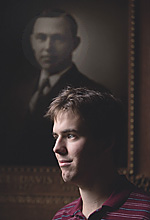Your Page
 One day during the winter semester of my freshman year, I discovered the portrait of my great-grandfather Royce Purinton, a member of the Class of 1900, Bates baseball coach, and director of athletics in the years before World War I.
One day during the winter semester of my freshman year, I discovered the portrait of my great-grandfather Royce Purinton, a member of the Class of 1900, Bates baseball coach, and director of athletics in the years before World War I.
I knew the portrait existed, but not where. Entering Alumni Gym to play basketball with friends, I paused to peer into Director of Athletics Suzanne Coffey’s office. There he was, staring down at me as if to say, “So this is what my family has degenerated into.” I was a typical first-year, enjoying newly found independence. The portrait fascinated me, but didn’t prompt me to figure out why it might be there. Paintings of old people hang in college buildings throughout New England, so I just figured one of my kin had managed to make the cut.
I had arrived at Bates from Toledo, Ohio, 881 miles from campus according to the trip odometer on my mom’s 1997 Town and Country. In August 2001, I traveled those miles to attend my sister’s wedding in the Bates Chapel. Before the ceremony, the male side of the wedding party played Wiffle ball on the Quad. I stood 50 yards from Hathorn Hall, where a year later I would struggle in French class.
Even then I was incurious about my family’s Bates history, even though the Purinton family tree is populated with Bates alums. My sister, now Elizabeth J. Purinton Izaki, is Bates ’98. Our father is Bates ’64, and his brother, Royce III, is ’61. Their father is Royce Jr. ’35. His father and mother were Royce D. — the man in the portrait — and Rena Dresser Purinton, both Bates ’00.
But that was then. Last August, after three great years at Bates — weekend fun, intramural sports, varsity golf, the occasional school work, and a junior spring in Rennes, France — I was back on campus with the sudden and terrifying realization that the protective shield labeled “college student” would expire in nine months. Perhaps it was that terror that awakened my interest in my great-grandfather and a general questioning as to what it will mean to be the youngest Bates alum in a family filled with garnet genes.
One day last fall, I headed to the library to look at issues of The Bates Student from 1919, when Royce Purinton returned from France and service with the YMCA in World War I. The sheer size of one headline shocked me: “Purry Back from France.” Purry? Such an odd nickname for that formal-looking man in the portrait.
Yet he was revered at Bates, almost embarrassingly so. As an undergrad, he earned four letters each in baseball and football, quarterbacking the football team to its first undefeated campaign his junior year and captaining both sports his senior year. As Bates AD, with poor sportsmanship and paid athletes common in the college ranks, he forged the College’s reputation for clean play and high academic standards, which helped put Bates onto the athletic schedules of schools like Harvard and Yale. “His one ambition,” the Student noted, “was to see real men go forth from the College rather than…prized athletes or winning teams.”
In 1918, at age 40, he volunteered to go to France with the YMCA, which during World War I handled the military’s soldier-welfare programs. At first he organized athletic events, signing 40 land leases to create playing fields and putting together a Fourth of July athletic tournament for 20,000 soldiers.
Then he went to the front. In two days of fighting, according to the Student, he witnessed the loss of 1,800 men. And while he was in France, tragedy struck back home when his 10-year-old daughter, Frances, died during the influenza pandemic.
He returned to Bates in January 1919. But, it was noted, the once-vigorous man seemed to tire easily. As the Student later reported, his experience at the front “did not contribute to his welfare.” In March 1919, he failed to attend a big track meet and was admitted to Pleasant Hill Sanitarium under suspicion of tuberculosis. Tests were negative, and friends suspected a nervous breakdown but expected a recovery. He died unexpectedly on March 25, 1919.
In recent years, when my father visited Bates for Parents and Homecoming weekends, we would sometimes stop by Royce’s grave in Riverside Cemetery, a five-minute walk from campus. As an alum, I will want to continue that ritual, as it will have deeper meaning now that I understand his contributions to Bates.
For now, just knowing a little more about my family’s Bates history is the first step toward fulfilling the obligations that it necessarily entails. But like all seniors, I have practical matters at hand too. Right now, I need to worry about my thesis.